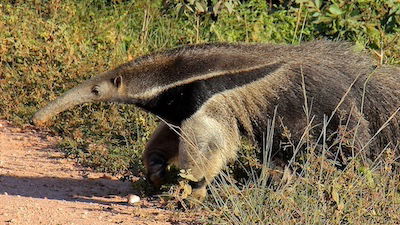Tiptoes and Trunks
The “sixth” key to a balanced view of foot evolution . . . or design!
News Source
- Science: “Elephants Have a Sixth ‘Toe’”
The death and dissection of a circus elephant in Dundee, Scotland, three centuries ago began an ongoing debate about how many toes an elephant has. What was thought initially to be a sixth toe later was deemed to be only cartilage, but recent investigation at the Royal Veterinary College (RVC) has found the “false toe” is a bone after all. The RVC team believes it has figured out the evolutionary history of the elephant’s ancestral foot.
Professor John Hutchinson’s team determined the sixth toe is a giant sesamoid bone—a bone formed by the ossification of cartilage long after other bones ossify. By examining Hutchinson’s collection of preserved elephant feet, they determined the sesamoid bone, like most sesamoid bones, becomes more densely ossified with age. Most sesamoid bones form within tendons or ligaments, but this one, embedded in a fat pad, is similar to a panda’s “extra” thumb. Initially appearing useless, the sixth toe does “change position and come into contact with the ground.” The team also found, by manipulating the preserved feet to bear weight, that the sixth toe functions differently on the front and back feet.
Thanks to the large sesamoid’s patchy ossification, both front and back feet have “an unusually flexible ossified structure that nevertheless is stiffer than the surrounding fat pad or cartilage.”1 However, the sixth toe in the back foot bends to transfer the elephant’s weight onto its tiptoes, “providing a more passive stabilizing support that reduces need for more active and massive muscular tissues.”2 This unique design makes the elephant into a sort of natural ballerina, able to support its great weight on tiptoes.
All the elephant and mammoth foot fossils resemble those of modern elephants with evidence of the sesamoid bone.
Hutchinson also performed CT scans on fossils of elephants, mammoths, and supposed elephant ancestors. All the elephant and mammoth foot fossils resemble those of modern elephants with evidence of the sesamoid bone. The feet of supposed elephant ancestors are poorly preserved, but scans of their leg bones suggest they lacked this foot adaptation. Therefore, the team concludes elephant ancestors had flat feet and modern elephants evolved the sixth toe-like modification to make the tiptoe foot design carry elephant weight efficiently.
“As far as we know,” an RVC spokesman says, “elephants are the only animals to use enlarged sesamoid bones in this new supportive role. Other large land mammals have lost them and thus never developed a large fatty foot pad like elephants.”3
Since enlarged sesamoid bones in pandas and moles are adapted for the specialized functions of climbing and digging, Hutchinson considers the elephant’s sesamoid sixth toe to be a convergently evolved example “of evolutionary exaptation: co-option of old structures for new functions.”4 He believes the recruitment of a sesamoid bone for this function would be easier than re-evolving the standard five-digit foot into a six-digit one.
The “ancestral elephants” to which the team compared their modern specimens were Barytherium and Numidotherium.5 The Barytherium is an extinct animal whose fossils lack any evidence of a trunk. The Numidotheirum is a sort of tapir, not an elephant. The only way to consider these animals as ancestral elephants is to use the imagination. Since fossilized feet of real elephants and mammoths resemble modern elephant feet, there is no evidence of elephant foot evolution (or even diversification) in the fossil record.
Furthermore, sesamoid bones are found in many species and provide “as needed” parts that ossify into bone in relation to the stress placed on them. In humans, for instance, the kneecap is only a bit of cartilage in the newborn but with use becomes an important bony fulcrum. The elephant’s sixth toe is able to function with remarkable flexibility as a weight-supporting strut and a weight-shifting lever because its patchy ossification forms in the response to the elephant’s weight. Similarly, the panda’s foot and the mole’s foot are equipped with sesamoid structures able to ossify in response to those animals’ needs.
A Swiss evolutionary morphologist commented, “Even animals as 'well known' as elephants can be subject of exciting, new discoveries, the study of which provides major insights into evolution.” However, the sesamoid bone of the elephant foot is not an evolutionary experiment that led to a new kind of foot. The fossil record does not demonstrate any such evolutionary progression. Furthermore, while variation and speciation do occur, evolution of one kind of creature into another is inconsistent with biblical history.
What this team has discovered is a phenomenal design feature of elephant anatomy, engineered by the Master Engineer, the Creator God of the Bible. He created the elephant kind on the sixth day of Creation week about 6,000 years ago. He equipped the elephant with an efficient foot design whose secrets are just now being discovered and appreciated.
For More Information: Get Answers
Remember, if you see a news story that might merit some attention, let us know about it! (Note: if the story originates from the Associated Press, FOX News, MSNBC, the New York Times, or another major national media outlet, we will most likely have already heard about it.) And thanks to all of our readers who have submitted great news tips to us. If you didn’t catch all the latest News to Know, why not take a look to see what you’ve missed?
(Please note that links will take you directly to the source. Answers in Genesis is not responsible for content on the websites to which we refer. For more information, please see our Privacy Policy.)
Footnotes
- John R. Hutchinson et al., “From Flat Foot to Fat Foot: Structure, Ontogeny, Function, and Evolution of Elephant “Sixth Toes,” Science 334, no. 6063: 1699–1703, doi:10.1126/science.1211437.
- Ibid.
- Rob Waugh, “Mysterious ‘Sixth Toe’ Is Confirmed in Elephants—and Bone Is Crucial to How They Balance All that Weight,” The Daily Mail, December 23, 2011, http://www.dailymail.co.uk/sciencetech/article-2077937/Secret-elephants-mysterious-sixth-toe-revealed-300-years-after.html
- Hutchinson et al., “From Flat Foot to Fat Foot.”
- Ibid.
Recommended Resources

Answers in Genesis is an apologetics ministry, dedicated to helping Christians defend their faith and proclaim the good news of Jesus Christ.
- Customer Service 800.778.3390
- Available Monday–Friday | 9 AM–5 PM ET
- © 2025 Answers in Genesis






